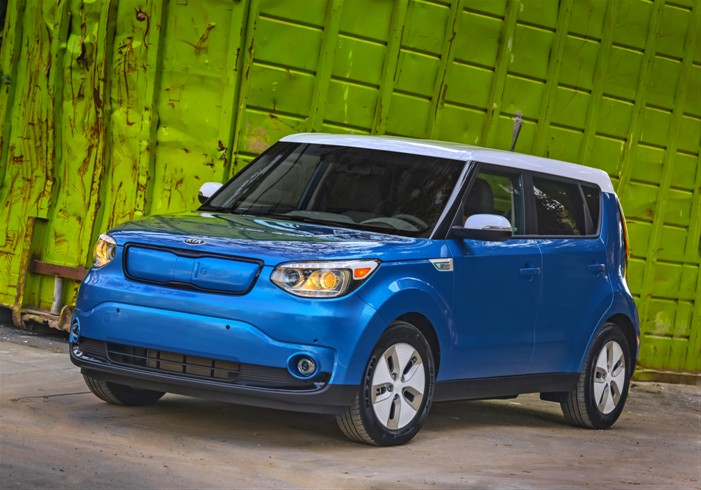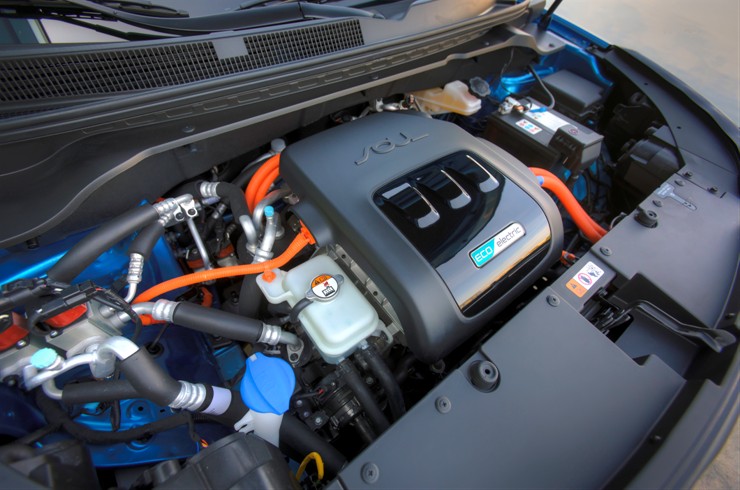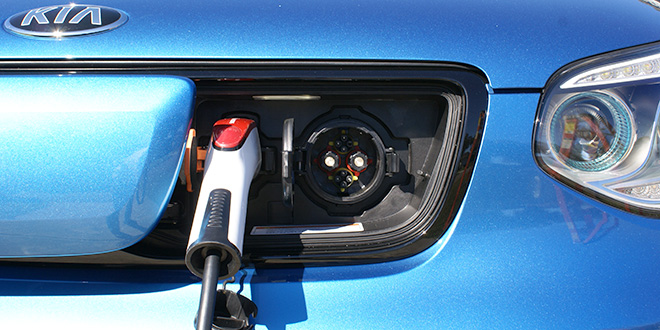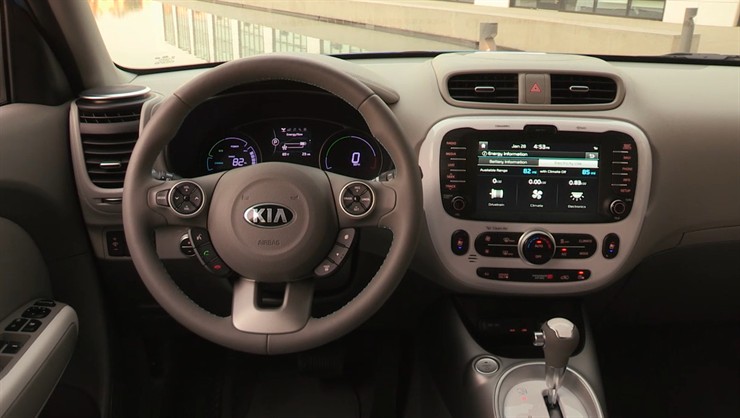Fun-and-Funky Goes Green: Soul EV Arrives as Kia’s First All-Electric Vehicle in the U.S.
- Eco-friendly Soul EV positions brand as a true stakeholder in the growing green segment
- The impressive 27kWh lithium battery delivers EPA estimated 93 miles of range
- Soul EV achieves EPA MPGe1 of 92 miles highway and 120 miles city for a combined mileage rating of 105 miles
As the centerpiece of the Kia’s ‘Clean Mobility’ efforts, the Soul EV is the embodiment of the brand’s environmentally focused mission, transforming the hip urban crossover into Kia’s first mass-market, all-electric zero emissions vehicle to be sold in the U.S. Combining the iconic design of the Soul with advanced eco-friendly technology has landed the Soul EV in a class all its own. Honored with an industry-first automotive environmental validation by Underwriters Laboratory (UL) for its innovative use of bio-based materials, the Soul EV also earned an EPA estimated range rating of 93 miles with an MPGe of 92 miles highway and 120 miles city for a combined mileage of 105 miles.
“This is a momentous time for Kia as we venture further into the eco-friendly space with our first globally available all-electric urban crossover vehicle,“ said Orth Hedrick, vice president of product planning, Kia Motors America. “The one-of-a-kind design of the Soul has proven to be a favorite with customers and when coupled with the state-of-the-art battery, providing top efficiency in range and regenerative energy, it becomes a winning combination of individualistic style, user-friendly functionality and eco-friendly capability.”
The Soul EV conveniently features two standard charging ports, a SAE J1772 port for Level 1 and Level 2 AC charging, and a CHAdeMo DC fast-charging port (480v). It can be charged to 80 percent in as little as 33 minutes with a 50 Kw–output fast charger (five hours using a 240v outlet). Set to launch initially in the ultra-EV-friendly state of California, the lively crossover will go on sale in additional select markets in 2015.
High Energy Density Battery and Usable Power
A top concern for EV buyers has commonly been range anxiety. The Soul EV addresses this issue with a highly energy-dense lithium-ion polymer battery. Located beneath the floor, the 27kWh, air-cooled, 200 watt-hour/kg battery enables an EPA estimated range of 93 miles, which is better than all other EVs on the market except the Tesla Model S luxury EV.
The 360-volt, 192-cell, lithium-ion polymer, gel-electrolyte battery has been engineered for high capacity, thermal stability and safety. Accordingly, the battery features a nickel-cobalt-manganese cathode, which helps increase capacity, and a carbon graphite-based anode, which increases durability while reducing weight.
In an effort to maximize efficiency and range, the Soul EV uses Kia’s third-generation regenerative braking system to capture up to 12 percent of the car’s kinetic energy, which is fed back into the battery while the Soul EV is coasting and braking. Soul EV owners can choose between four drive mode combinations: “Drive” or “Brake” modes in Eco-mode “Off,” and “Drive” or “Brake” modes in Eco-mode “On” (the “Brake” or “B” setting with Eco-mode “On” producing the most regeneration).
The Soul EV makes charging easy by plugging into any standard 120v outlet or a conventional 240v EV charger. Two charging ports are standard, including a SAE J1772 port for Level 1 and Level 2 AC, and a CHAdeMo DC fast-charging port (480v). Found behind a sliding door located in the front grille, the dual ports offer flexibility and increase the Soul EV’s go-anywhere appeal, making it more convenient to charge inside the owner’s garage or when on the road. Recharging times vary from 24 hours for a fully depleted battery using a standard 120v outlet and under five hours when plugged into a 240v outlet. An 80-percent charge can be achieved from empty in as little as 33 minutes with a 50 kW-output DC fast charger. Kia has partnered with three charger providers – Bosch, Leviton and AeroVironment™ – which give Soul EV buyers an opportunity to select the unit best suited to their in-home needs.
Additionally, the 17 Kia retailers participating in the first wave of the Soul EV launch each will be equipped with multiple Level 2 chargers and a DC fast charger, bringing California’s DC fast charging network total to 215, a nearly nine percent increase statewide. KMA’s EV charging infrastructure plan provides Soul EV buyers with broad coverage, flexibility and excellent support, and Kia’s networking partnership with Greenlots will connect customers to DC fast chargers in convenient locations throughout California.
The front-wheel drive Soul EV is powered by a 109-hp (81.4kW) electric motor, producing a generous 210 lb.-ft. of instantaneous torque. The liquid-cooled AC synchronous permanent magnet motor uses multi-layer magnets to help improve efficiency and reduce the whine common to most electric vehicles. The motor delivers its power to the front wheels through a single-speed constant-ratio gear reduction unit. Acceleration from 0-60 mph is expected to take fewer than 12 seconds with top speed electronically limited to approximately 90 mph. The battery’s location beneath the floor results in a lower center of gravity, which helps ride and handling and ensures that the EV remains true to the Soul’s fun-to-drive reputation. Additional cross bracing beneath the low-mounted battery contributes to a 5.9 percent improvement in torsional rigidity over the gasoline-powered Soul and offers protection to the battery.
Improved aerodynamics and the absence of engine noise, combined with special sound-proofing materials, result in an exceptionally quiet ride. For the benefit of pedestrian safety, the Soul EV is equipped with a Pedestrian Warning System (PWS) that emits an auditory alert at speeds below 12 mph and whenever the car is in reverse.
Minimal Battery Intrusion
The Soul EV offers plenty of space inside the cabin thanks to minimal battery intrusion. Because of the battery’s flat design and location beneath the floor, there is only a slight 3.1-inch reduction to rear seat leg room (from 39.1 to 36 inches) versus the non-EV Soul, yet Soul EV still offers more rear seat leg room than other key EV competitors. Rear shoulder and hip room remain unchanged from the gasoline-powered Soul, making Soul EV one of the roomiest in the segment. Rear cargo space of 18.8 cu.-ft. (with rear seats up) is also unchanged from the internal combustion engine Soul, and the under-cargo tray provides convenient storage for the standard 120v portable charger.
Uniquely Designed Inside and Out
The Soul’s bold exterior design carries over to the EV. From the “floating” roof to the greenhouse that makes the car look like it is wearing wraparound sunglasses, the EV’s look is inspired by the 2012 Kia Track’ster concept and retains the iconic square-shouldered broad stance of the original Soul. Initially, the Soul EV will be offered in four color choices: Caribbean Blue lower body with Clear White roof, Shadow Black lower body with Inferno Red roof, Titanium Gray and Clear White. The signature two-tone paint theme is exclusive to the EV and was inspired by a similar treatment seen on the Track’ster. The EV-exclusive front fascia includes a larger grille area to accommodate the charging ports, and other unique exterior Soul EV design features include color accent trim in the front and rear fascias, projector headlights, LED positioning lamps, and LED tail lights. “Eco Electric” fender badging replaces the “Soul” fender garnish found on the gasoline-powered car, and the Soul EV gets its own set of distinctive 16-inch alloy wheels wrapped with specially engineered Super Low Rolling Resistance (SLRR) tires that offer 10 percent less resistance than standard low rolling resistance tires, helping to improve range.
When launched in 2014, the all-new Soul was lauded for its premium interior and significantly reduced levels of NVH. The Soul EV will be instantly recognizable for these same qualities. Like its gasoline-powered sibling, a circular theme pervades the cabin and is a pleasing contrast to the exterior’s angular good looks. Inside, the Soul EV sets itself apart from its gasoline-powered sibling with bright white accent trim on the center console, instrument panel and door panels, lending a light and modern feel to the passenger space. Distinguished by Kia’s most extensive use of bio-based materials, the Soul EV has received UL’s first ever automotive environmental claim validation for its 52.7 lbs. of bio-based organic content in interior plastic. Front and center is the use of BTX-free paint on the audio system surround, vent bezel and the floor console. Bio-based plastics derived from cellulose and sugar cane are found in many places within the cabin, including the door panels, headliner, seat trim, roof pillars and carpeting. In all, organic, bio-based materials are used in 19 different interior parts.
The Soul EV features exclusive interior color options that perfectly complement the exterior. Two interior seating materials will be offered: Standard eco-friendly cloth or optional leather. Both are two-tone gray with offsetting blue stitching on the cloth seats and blue or black (Shadow black model) piping on the leather seats. Additional blue stitching (grey stitching on Shadow Black models) is found on the steering wheel and center console armrest. piping blue stitching on the cloth or seating materials will be offered: Standard eco-friendly cloth or optional leather.
Standard Soul EV amenities include a Navigation with eight-inch screen, a 6.6kW on-board charger, CHAdeMO DC fast charge port, Rear Camera Display, Bluetooth® hands free operation, power windows, power driver’s seat, cruise control, and an exclusive HVAC system designed to extend driving range by minimizing energy draw.
Air conditioning is one of the largest energy drains in any electric vehicle, but the Soul EV’s HVAC system is designed to provide optimum comfort while also helping to extend the car’s range by minimizing energy use. The Soul EV uses four key technologies to maximize HVAC efficiency: a standard heat pump, individual ventilation, scheduled ventilation, and air intake control. The heat pump efficiently combines the A/C and heater into one system while greatly reducing energy consumption. It also utilizes waste heat from the Soul EV’s electrical systems to help heat the cabin. Individual ventilation allows selection of “Driver Only,” which stops airflow to the passenger side front dash and floor vents and the floor vents for the rear passenger compartment, thereby focusing airflow on the driver and reducing the amount of energy needed to reach a comfortable interior temperature. Scheduled ventilation reduces EV energy use by pre-heating or cooling the passenger compartment prior to starting the car, while it is still plugged into a charger. Air intake control regulates inner and outer air flow to minimize HVAC usage, regulating interior temperature by carefully managing recirculated cabin air.
Forward Thinking Technology
Available at no cost for the first five years of ownership, UVO EV Services, a special version of Kia’s award-winning telematics and infotainment system, is put to even greater use in the Soul EV. Utilizing an embedded connectivity solution powered by the Verizon network and an integral smartphone app, UVO EV Services provides owners with an innovative, real-time, in-vehicle connectivity experience that includes navigation and added convenience features specifically tailored for the Soul EV to help owners stay informed as to their vehicle’s charging status while on the go. UVO EV Services provides real-time battery-level status, distance to empty, and the ability to search for nearby charging stations. Also, via the UVO EV app, owners can preset charging time and charging level ratios, as well as precondition the vehicle cabin with remote control of the HVAC presets. Preconditioning the vehicle moderates cabin temperature in advance, helping reduce battery draw once the Soul EV is uncoupled from the charging station. At a glance, UVO will also update EV owners of their CO2 savings and their relative positive impact on the environment.
Introduced for the first time on the Soul EV, UVO EV Services includes downloadable apps that reside on the Soul EV’s standard 8-inch capacitive-touch navigation screen. EV owners may download Yelp®, the online urban city guide that helps people find cool places to eat, shop, relax and play. Soul EV owners will also enjoy iHeartRadio, the free, all-in-one digital radio service that lets customers listen to their favorite live stations or create their own commercial-free, all-music custom stations. Sound Hound, which is also available and accessible through the touch screen, listens to what’s playing and displays all related information such as lyrics, the artist, title and album cover art.
Arriving with a five-year complimentary subscription to SiriusXM™ Data Services and Travel Link, the Soul EV has access to charging stations and travel information such as road conditions, weather and security alerts as well as sports scores, movie times and stock prices through the screen’s graphical interface and electronic program guide.
The Soul EV also features Kia’s first use of Organic Light Emitting Diode (OLED) technology. Low energy consumption and virtually no heat build-up make OLED perfect for an electric-vehicle application. Found within the Soul EV’s exclusive Supervision instrument cluster, the 3.5-inch OLED screen is crystal clear and provides information on the vehicle’s energy flow, charging time, ECO driving level and energy economy, which measures how efficiently the battery is operating. Additionally, the OLED screen provides a three-stage alert for the Soul EV’s State of Charge (SOC), which allows the driver to quickly determine how much charge remains within the battery and when it’s time to plug in to a charging unit.
 Asian Fortune Your source for all things Asian American
Asian Fortune Your source for all things Asian American






One comment
Pingback: Latest Electric Sunglasses Sale News | Aborsp.com